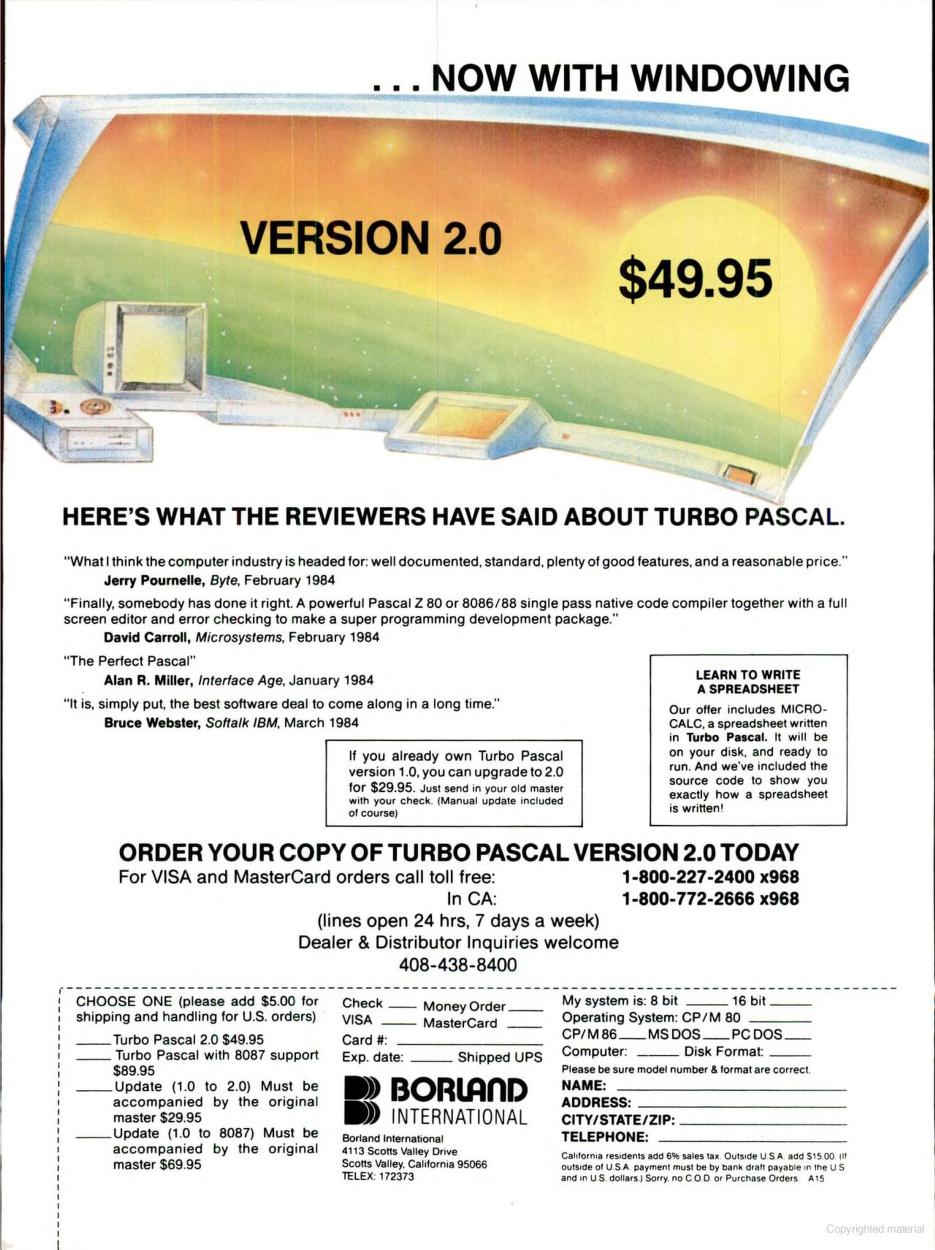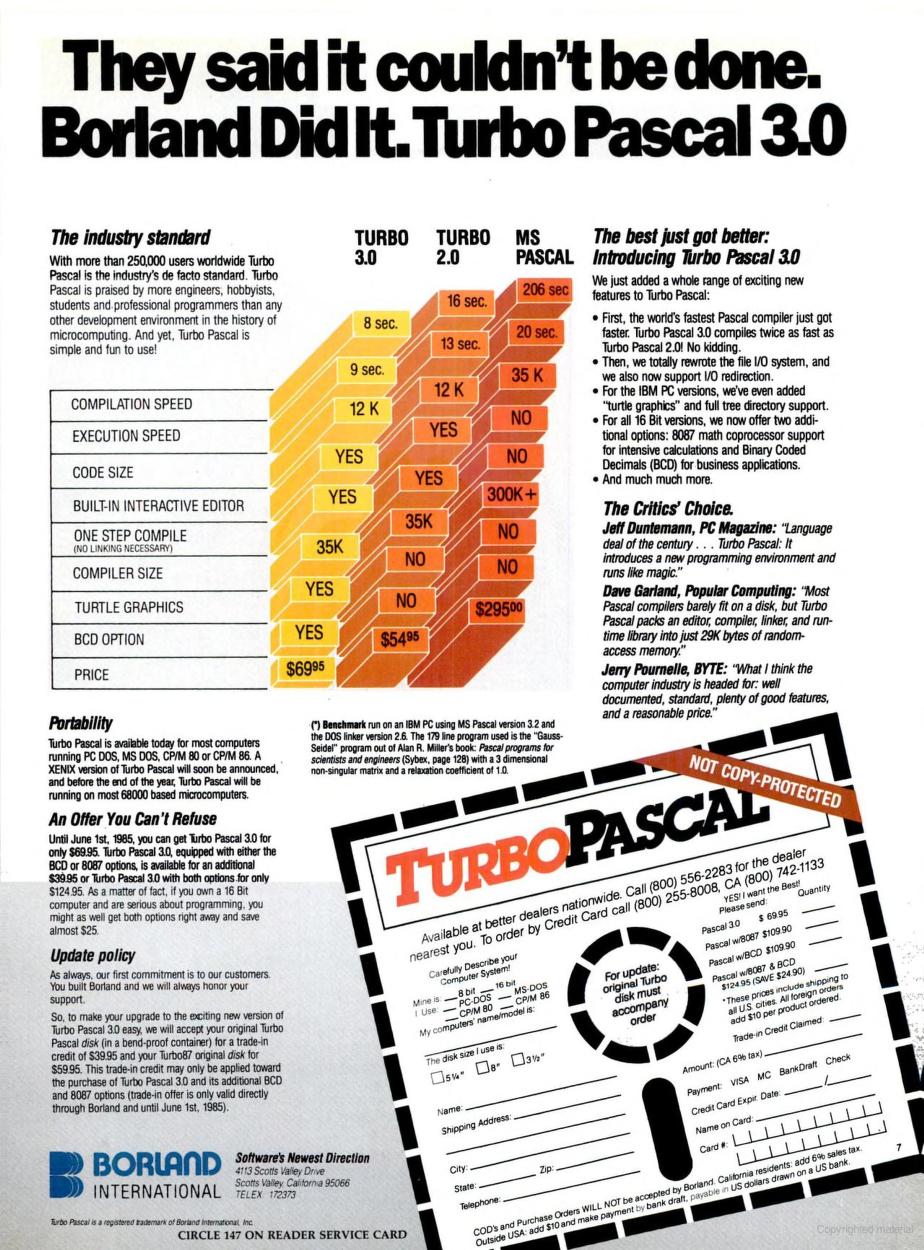Borland International, Inc.
Turbo Pascal
Turbo Pascal began life as Compas Pascal, written by Anders Hejlsberg, and sold commercially in Denmark via his company, Poly Data.
With the release of Turbo Pascal, Borland started its award winning push into the world of development environments and tools. Borland Inc., based in Santa Cruz, CA., licensed the Pascal compiler core and added the user interface and editor. Anders joined the company as an employee and was the architect for all versions of the Turbo Pascal compiler and the first three versions of Borland Delphi.
Version 1.0 started shipping on 20th November 1983 with mail order adverts being placed in the popular Byte Magazine. By design the product had very low system requirements: an Intel 8088/8086 or Zilog Z80 CPU and just 64 KB of RAM. DOS versions came on a single 5.25" floppy disk and the CP/M version was available on either 5.25" or 8" floppy disk.

One of the most popular features of Borland's compilers was that they featured an IDE, or Integrated Development Environment. At the time, some referred to these as "Edit-Compile-Run" development environments. While it may not seem any better than, say, GWBASIC, in 1983 a compiler was a professional tool and it was more typical to use your favourite programmers' text editor (like Brief) to write code and then run the compiler and linker from the command-line to create a .EXE file.
With an IDE you could write and format your source code, configure all of the compiling options such as memory usage, and then either run it "in-memory" or compile it to an executable file. When compiling, it would create an object code file as well - an intermediate file between the high-level language you programmed in and the binary executable file. These would have a .OBJ file extension.
Code size was limited to 12 KB with the compiler using up 35 KB of available memory.



From left: Turbo Pascal 1.0's main menu, compiler options, and built-in editor
To showcase its capabilities, the product also came with a pretty full-featured spreadsheet with source code, called MicroCalc.
In 2000 Turbo Pascal 1.0 [as well as versions 3.02 and 5.5] was released free of charge to the Borland developer community for personal, non-commercial use.
Turbo Pascal 2.0 arrived in May 1984 with a price tag of $69.95, adding 'windowing' (the ability to declare a portion of the screen and output will then be automatically written to that window), automatic overlays and heap memory management, and optional support for the 8087 math coprocessor for an additional $40 more. Those upgrading from 1.0 could get version 2.0 for just $29.95.
Turbo Pascal 3.0 was launched in April 1985 (again for $69.95 for the base product) and featured faster compiling and execution speeds. It was also the first version to optionally support the Intel 8087 math co-processor (16-bit PC version). It also included optional support for Binary Coded Decimal (BCD) math to eliminate round off errors in business applications - both these options could be purchased for $39.95 over the base price. Turbo Pascal 3 also allowed you to build larger programs (> 64 KB) using overlays. The PC version also supported Turtle Graphics, color, sound, window routines, and more. It still ran on a humble 8086/8088 PC but required 128 KB of RAM. Version 2.0 was still available if your wallet couldn't stretch to the latest version, for $54.95.
Turbo Pascal 3.02 shipped on 17th September 1986 as a minor bug fix over 3.0.



From left: Turbo Pascal 3.02's startup screen, main menu, and built-in editor
In 1987, Borland released Turbo Pascal 4.0 for $99.95 as a full product or $39.95 for those upgrading from an earlier version. It featured are much more user-friendly interface, offered twice the performance of version 3.0, added 'Uses' for separate compilation of modules, a built-in project 'Make', and came also with a command-line compiler. It also added interactive error detection and location to the IDE.




Borland Turbo Pascal version 4.0
In this version, Borland introduced the concept of Units with the following seven available out of the box for the DOS version:
- Crt - Input and output routines for your text screen, including windowing, direct cursor addressing, text colour, background, etc.
- Dos - Contains a set of regularly-used DOS calls, such as GetTime, SetTime, DiskSize, etc.
- Graph - Contains a set of fast graphics routines using the device-independent Borland Graphics Interface (BGI) handler. Supports Hercules, AT&T 400, 3270 PC, CGA, EGA and VGA.
- Printer - Allow your program to send data to the printer.
- System - Contains all procedures and functions that are specific to Turbo Pascal.
- Graph3 - The full set of graphics routines from Turbo Pascal 3.0.
- Turbo3 - Contains variables and procedures that are no longer supported by Turbo Pascal. Included for backward-compatibility purposes.
These units are not like Include files in C - they are precompiled into machine code already, and reside in .TPU files (all but the Graph one above are in the file TURBO.TPL). You can of course create your own units and these need to be compiled along with your main program.
Coupled with the release, Borland also introduced a series of complementary "Turbo Toolboxes" that would work with Turbo Pascal, including:
- Turbo Pascal Database Toolbox - tools to help your Turbo Pascal program to read from/write to large data files, and sort records fast.
- Turbo Pascal Graphix Toolbox - a set of procedures and functions to aid in drawing lines, rectangles (with shading), points, ellipses and circles on a high-resolution black & white display.
- Turbo Pascal Editor Toolbox - a set of procedures and functions to aid in creating full-featured text editors and word processors.
- Turbo Pascal Numerical Methods Toolbox - a set of procedures and functions to aid in numerical analysis such as finding solutions to equations, interpolation, calculus, derivatives and integrals, matrix operations and more.
- Turbo Pascal Gameworks - three strategic games with source code that provide insight into programming decision-making software.
The compiler could be bought together with the toolboxes if you bought the Turbo Pascal 4.0 Developer's Library for $395, which also bundled in Turbo Pascal Tutor. The toolboxes were also available individually for $99.95 each, or $29.95 for those upgrading from earlier versions, and the Tutor for $69.95 or $19.95 respectively.
In August 1988, Turbo Pascal 5.0 was released at a cost of $149.95 (about $50 more than Microsoft's Quick Pascal). Featuring advanced source-level debugging with watches, step throughs and breakpoints, 8087 emulation for floating point (even without a math coprocessor), better IDE configuration with options to change the editor colour scheme, support for EMS, support for Turbo Assembler and Turbo Debugger, a smart linker that removes unused code and data at link time, and even better performance (2.5x - 3x the compilation speeds of TP3.0). A new standard unit called "Overlay" could be used to implement TP5.0's powerful overlay manager (overlays are parts of a program that share a common memory area - only parts of a program that are required for a given function reside in memory at the same time).




Borland Turbo Pascal version 5.0
In December of this year, Turbo Pascal 5.0 was the 7th best-selling software package on the market. Ahead of it were Lotus 1-2-3 2.01, Quicken 2.0, WordPerfect 5.0, PC Tools Deluxe 4.3, dBase III Plus 1.1, and Fastback Plus 2.01.
In May 1989, Turbo Pascal 5.5 arrived for the same price as 5.0 ($149.95), but could also be bought as a bundle called Turbo Pascal Professional 5.5 which included Turbo Debugger 1.5. The key feature it added over 5.0 was object-oriented extensions. The IDE also got a built-in 'Tour' option to provide an introduction to the IDE, and the online help included examples you could copy/paste into your code. Borland upgraded the separate Turbo Debugger product from version 1.0 to 1.5 which supported objects. The overlay manager now allowed you to specify pre-defined variables to monitor overlay activities.




Borland Turbo Pascal version 5.5
This year, Microsoft replaced their more expensive Microsoft Pascal product with QuickPascal, designed to compete directly with Borland Turbo Pascal at the lower price point. Unlike its forebear, QuickPascal had an IDE like Borland's, and was even written to be source code-compatible with Turbo Pascal, including Units.
Turbo Pascal 6.0 provided even more enhancements, arriving in October 1990 for $149.95 or $69.95 if upgrading from an earlier version. A 'Professional' version was also available that included Turbo Drive (for compiling large applications in extended memory (XMS), Turbo Debugger 2.0, Turbo Profiler 2.0 for performance tuning your application and Turbo Assembler 2.0, all for $299.95. Turbo Pascal 6.0 included what Borland called Turbo Vision - an object-oriented application framework for DOS that allowed you to create windowed applications with pull-down menus and mouse support with ease. The IDE now supported multiple open files at the same time, and with the built-in Turbo Help you could take examples of any Pascal library routine and compile and run it for use in your own program.




Borland Turbo Pascal version 6.0
The last version for DOS was Turbo Pascal 7.0, released in 1992. It came with a new IDE, TPX, suitable for use when developing very large programs - it could access up to 16 MB of memory. Other enhancements included a built-in Object Browser, syntax highlighting, user-installable help files, and many optimisations to the debugger and compiler.
Borland began developing versions of Turbo Pascal for Windows starting in late 1991. It was succeeded by Borland's own Delphi in 1995.
More Advertisements




Some more magazine advertisements for Borland's Turbo Pascal